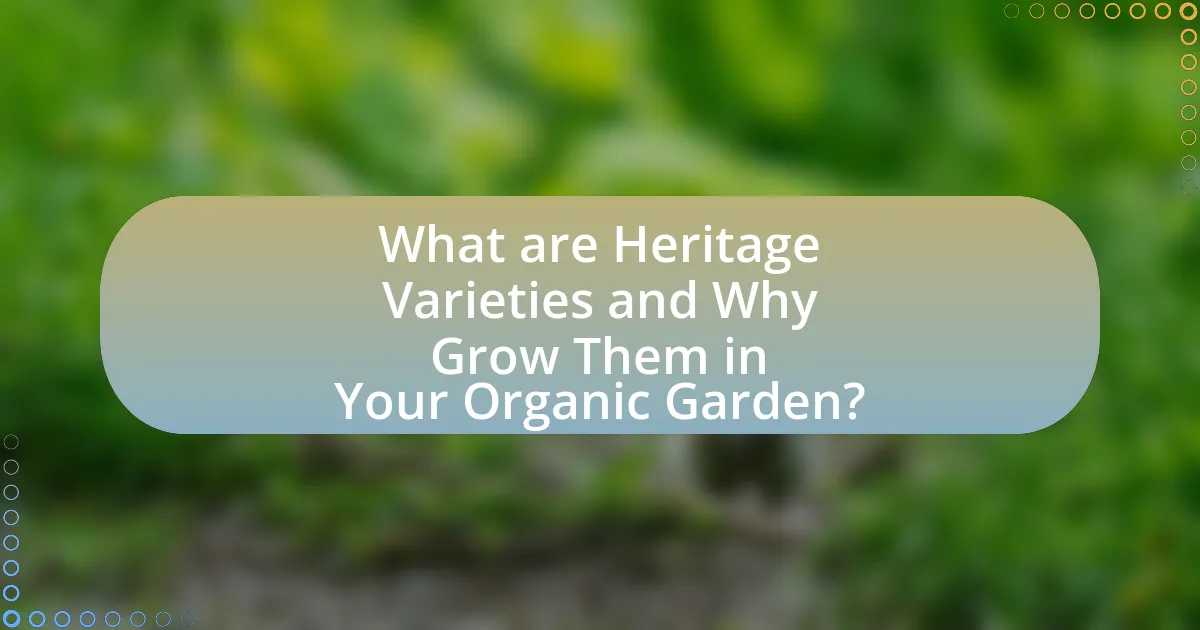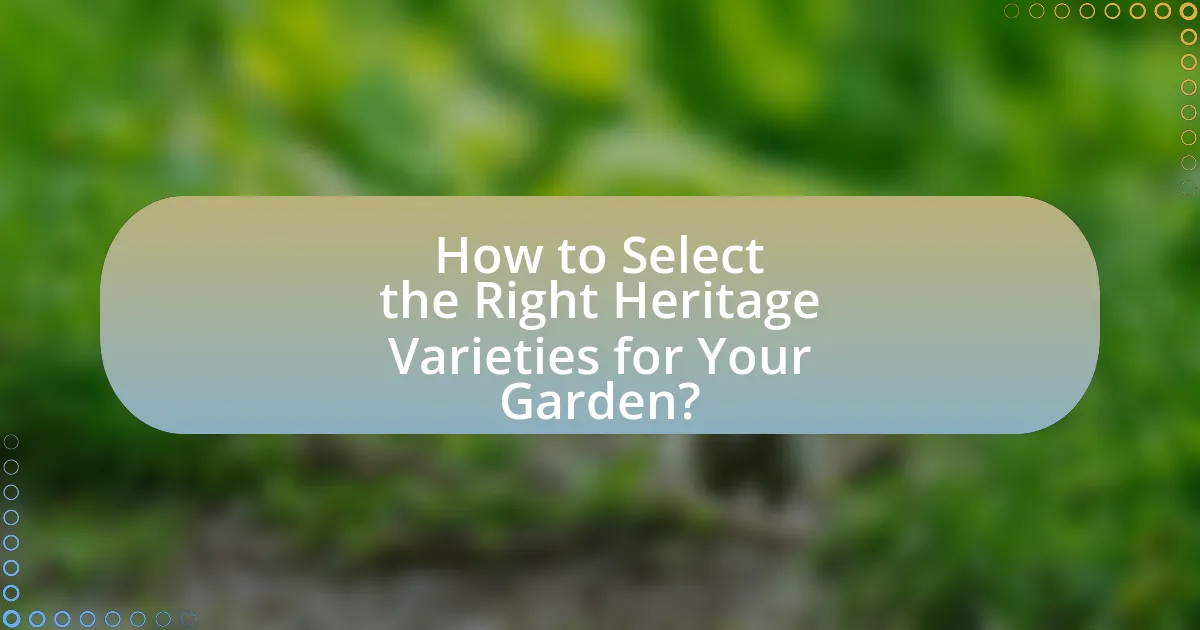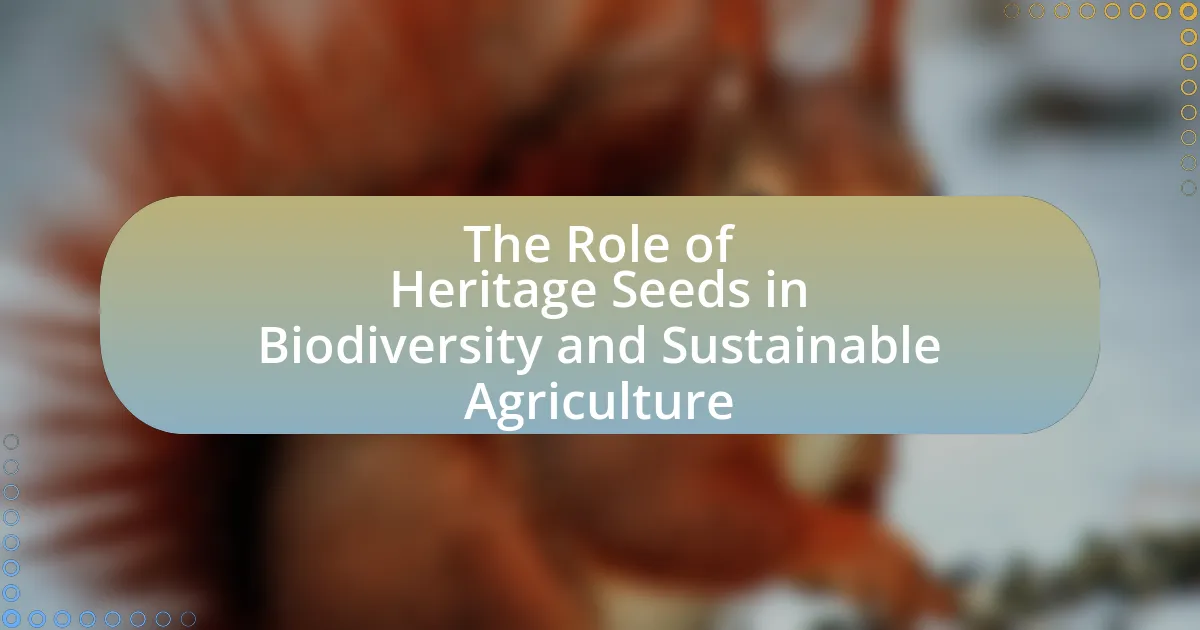Heritage varieties are traditional plant cultivars that have been preserved over generations, known for their unique flavors, resilience, and adaptability to local conditions. This article explores the significance of growing heritage varieties in organic gardens, highlighting their benefits for biodiversity, flavor, and sustainable agriculture. It details the differences between heritage varieties and modern hybrids, offers guidance on selecting suitable varieties based on local climate, and outlines best practices for cultivation, pest management, and soil health. Additionally, it provides insights into harvesting, preserving, and saving seeds from heritage varieties to ensure their continued availability and genetic diversity.

What are Heritage Varieties and Why Grow Them in Your Organic Garden?
Heritage varieties are traditional plant cultivars that have been preserved over generations, often characterized by their unique flavors, resilience, and adaptability to local growing conditions. Growing heritage varieties in your organic garden promotes biodiversity, supports sustainable agriculture, and helps maintain genetic diversity, which is crucial for food security. According to the Seed Savers Exchange, heritage varieties often have superior taste and nutritional value compared to modern hybrids, making them a valuable addition to any organic gardening practice.
How do heritage varieties differ from modern hybrids?
Heritage varieties differ from modern hybrids primarily in their genetic diversity and cultivation history. Heritage varieties are open-pollinated, meaning they can reproduce true to type, preserving unique traits over generations, while modern hybrids are often bred for specific traits, such as disease resistance or uniformity, and may not produce viable seeds. Additionally, heritage varieties typically have a broader genetic base, which can enhance resilience to environmental changes, whereas modern hybrids may rely on specific genetic modifications that can limit adaptability. Historical data indicates that many heritage varieties have been cultivated for centuries, contributing to their unique flavors and characteristics, while modern hybrids have been developed more recently, often within the last few decades, focusing on commercial viability.
What characteristics define heritage varieties?
Heritage varieties are defined by their traditional genetic traits, which have been preserved over generations through open pollination. These varieties typically exhibit characteristics such as adaptability to local growing conditions, unique flavors, and resistance to pests and diseases, which are often lost in modern hybrid varieties. For example, many heritage tomatoes are known for their rich taste and diverse colors, reflecting their long history of cultivation. Additionally, heritage varieties often have a lower yield compared to hybrids but are valued for their biodiversity and cultural significance in agriculture.
Why are heritage varieties important for biodiversity?
Heritage varieties are important for biodiversity because they contribute to genetic diversity within agricultural ecosystems. This genetic diversity enhances resilience against pests, diseases, and climate change, ensuring food security. For instance, a study published in the journal “Agricultural Systems” highlights that heritage varieties can possess unique traits that allow them to thrive in specific environmental conditions, which modern hybrids may lack. By preserving these varieties, we maintain a broader genetic pool that supports ecosystem stability and adaptability.
What benefits do heritage varieties offer to organic gardening?
Heritage varieties offer numerous benefits to organic gardening, including enhanced biodiversity, improved flavor, and resilience to local pests and diseases. These varieties contribute to a diverse ecosystem, which supports beneficial insects and soil health, ultimately leading to a more sustainable gardening practice. Additionally, heritage varieties often possess unique flavors and textures that are superior to commercial hybrids, making them more desirable for culinary uses. Research indicates that these varieties can also be more adaptable to specific local conditions, allowing for better growth and yield in organic gardens.
How do heritage varieties enhance flavor and nutrition?
Heritage varieties enhance flavor and nutrition by preserving genetic diversity and offering unique taste profiles that are often lost in modern hybrids. These varieties typically have been cultivated over generations, allowing them to develop richer flavors and higher nutrient content due to their adaptation to local growing conditions. Research indicates that heritage tomatoes, for example, can contain higher levels of antioxidants and vitamins compared to commercial varieties, which often prioritize yield over taste and nutrition. This is supported by studies showing that heirloom vegetables can have significantly different nutrient profiles, enhancing both culinary experiences and health benefits.
What role do heritage varieties play in sustainable agriculture?
Heritage varieties play a crucial role in sustainable agriculture by promoting biodiversity and resilience in farming systems. These traditional cultivars are often better adapted to local conditions, which enhances their ability to withstand pests, diseases, and climate variability. Research indicates that heritage varieties can contribute to soil health and ecosystem stability, as they often require fewer chemical inputs and support beneficial insects and microorganisms. For instance, a study published in the journal “Agriculture, Ecosystems & Environment” found that farms utilizing heritage varieties had higher levels of soil organic matter and improved nutrient cycling, which are essential for sustainable farming practices.

How to Select the Right Heritage Varieties for Your Garden?
To select the right heritage varieties for your garden, assess your local climate, soil type, and available space. Heritage varieties thrive in specific conditions; for example, tomatoes like ‘Brandywine’ prefer warm climates, while ‘Cavendish’ bananas require tropical environments. Additionally, consider the historical significance and adaptability of the varieties to your region, as many heritage plants have been bred for resilience in local conditions. Researching local agricultural extension services or seed banks can provide valuable insights into which heritage varieties perform best in your area, ensuring a successful and productive garden.
What factors should you consider when choosing heritage varieties?
When choosing heritage varieties, consider factors such as climate adaptability, disease resistance, and flavor profile. Climate adaptability ensures that the variety can thrive in your specific environmental conditions, which is crucial for successful growth. Disease resistance is important as it reduces the need for chemical interventions, promoting organic gardening practices. Flavor profile is significant because heritage varieties often offer unique tastes that can enhance culinary experiences. Research indicates that heritage varieties can have superior flavor compared to modern hybrids, making them a preferred choice for many gardeners.
How does your local climate affect variety selection?
Local climate significantly influences variety selection by determining which plants can thrive in specific environmental conditions. For instance, temperature ranges, humidity levels, and precipitation patterns dictate the growth and yield potential of various heritage varieties. Research indicates that crops adapted to local climates exhibit better resilience and productivity; for example, studies show that heirloom tomatoes perform optimally in regions with warm summers and moderate rainfall, as they require specific heat units for fruit development. Therefore, selecting varieties that align with local climate conditions enhances the likelihood of successful cultivation in organic gardens.
What are the best heritage varieties for specific growing conditions?
The best heritage varieties for specific growing conditions include ‘Brandywine’ tomatoes for warm climates, ‘Cavendish’ bananas for tropical regions, and ‘Kentucky Wonder’ beans for humid environments. These varieties have been selected based on their adaptability to particular climates and soil types. For instance, ‘Brandywine’ tomatoes thrive in warm temperatures and are known for their rich flavor, making them a popular choice among gardeners in warmer areas. ‘Cavendish’ bananas are cultivated extensively in tropical regions due to their resistance to disease and high yield. ‘Kentucky Wonder’ beans are favored in humid climates because they are resilient to moisture-related diseases and produce well in such conditions. These selections are backed by agricultural studies that highlight their performance in respective environments.
Where can you find heritage seeds or plants?
Heritage seeds or plants can be found at specialized seed banks, local nurseries, and online retailers that focus on heirloom varieties. Seed banks, such as the Seed Savers Exchange, preserve a wide range of heritage seeds and offer them for sale or trade. Local nurseries often carry heritage plants suited to the regional climate, while online platforms like Baker Creek Heirloom Seeds provide extensive catalogs of heirloom varieties. These sources ensure access to genetically diverse plants that have been cultivated for generations, supporting biodiversity and sustainable gardening practices.
What are reputable sources for purchasing heritage seeds?
Reputable sources for purchasing heritage seeds include Seed Savers Exchange, Baker Creek Heirloom Seeds, and Johnny’s Selected Seeds. Seed Savers Exchange is a nonprofit organization dedicated to preserving heirloom seeds, offering a wide variety of heritage seeds from diverse regions. Baker Creek Heirloom Seeds specializes in rare and heirloom seeds, providing detailed descriptions and growing information for each variety. Johnny’s Selected Seeds is known for its high-quality seeds and extensive catalog, including many heritage options, backed by research and customer support. These sources are recognized for their commitment to seed preservation and quality, making them reliable choices for gardeners seeking heritage seeds.
How can you save seeds from heritage varieties for future planting?
To save seeds from heritage varieties for future planting, allow the plants to mature fully and dry on the vine before harvesting the seeds. This ensures that the seeds are viable and retain the genetic traits of the heritage variety. After harvesting, clean the seeds by removing any plant material and store them in a cool, dry place in airtight containers. Research indicates that properly stored seeds can remain viable for several years, preserving the unique characteristics of heritage varieties for future planting.

What are the Best Practices for Growing Heritage Varieties in an Organic Garden?
The best practices for growing heritage varieties in an organic garden include selecting appropriate varieties, ensuring soil health, implementing crop rotation, and using organic pest management techniques. Selecting heritage varieties that are well-suited to local climates and soil conditions enhances resilience and productivity. Maintaining soil health through composting and organic fertilizers promotes nutrient availability, which is crucial for the growth of these varieties. Crop rotation prevents soil depletion and reduces pest and disease buildup, while organic pest management techniques, such as introducing beneficial insects and using natural repellents, help protect plants without synthetic chemicals. These practices are supported by research indicating that organic methods can improve biodiversity and soil quality, leading to healthier plants and better yields.
How should you prepare your garden for planting heritage varieties?
To prepare your garden for planting heritage varieties, start by selecting a suitable location with well-drained soil and adequate sunlight. Heritage varieties thrive in nutrient-rich soil, so amend the soil with organic matter such as compost or well-rotted manure to enhance fertility. Additionally, test the soil pH to ensure it falls between 6.0 and 7.0, which is optimal for most heritage crops.
Next, clear the area of weeds and debris to reduce competition for nutrients and water. Tilling the soil to a depth of at least 12 inches will improve aeration and root penetration. Finally, plan your planting layout to accommodate the specific growth habits and spacing requirements of the heritage varieties you choose, ensuring they have enough room to grow without overcrowding.
What soil conditions are ideal for heritage varieties?
Heritage varieties thrive in well-drained, loamy soil rich in organic matter. This type of soil provides essential nutrients and maintains moisture without becoming waterlogged, which is crucial for the health of these plants. Studies indicate that heritage varieties often perform best in soils with a pH range of 6.0 to 7.0, as this range optimizes nutrient availability. Additionally, incorporating compost or well-rotted manure can enhance soil fertility, further supporting the growth of heritage varieties.
How can you improve soil health organically?
To improve soil health organically, incorporate organic matter such as compost, cover crops, and mulch into the soil. Organic matter enhances soil structure, increases nutrient availability, and promotes beneficial microbial activity. Research indicates that adding compost can increase soil organic carbon levels by 10-30%, which is crucial for maintaining soil fertility and structure. Additionally, planting cover crops like clover or rye can prevent erosion, suppress weeds, and fix nitrogen in the soil, further enhancing its health.
What are effective cultivation techniques for heritage varieties?
Effective cultivation techniques for heritage varieties include selecting appropriate planting sites, using organic soil amendments, and implementing crop rotation. Heritage varieties thrive in well-drained, nutrient-rich soil, which can be enhanced with compost and organic fertilizers to promote healthy growth. Crop rotation helps prevent soil depletion and reduces pest and disease pressure, ensuring that heritage plants remain vigorous and productive. Research indicates that these practices not only support the unique characteristics of heritage varieties but also contribute to sustainable gardening practices, as evidenced by studies showing improved soil health and biodiversity in organic systems.
How do you manage pests and diseases organically?
To manage pests and diseases organically, implement a combination of cultural practices, biological controls, and natural pesticides. Cultural practices include crop rotation, companion planting, and maintaining healthy soil to promote plant resilience. Biological controls involve introducing beneficial insects, such as ladybugs and parasitic wasps, which prey on harmful pests. Natural pesticides, derived from plant extracts or minerals, can be used as a last resort; for example, neem oil disrupts the life cycle of pests without harming beneficial organisms. Research indicates that these methods can effectively reduce pest populations while maintaining ecological balance, as demonstrated in studies published by the Organic Farming Research Foundation.
What watering and fertilization practices are best for heritage varieties?
Heritage varieties thrive best with consistent watering and organic fertilization practices. These plants typically require deep watering to encourage strong root systems, ideally providing about 1 to 2 inches of water per week, depending on climate and soil conditions. Organic fertilizers, such as compost or well-rotted manure, should be applied during the growing season to supply essential nutrients, as heritage varieties often benefit from the slow release of nutrients found in organic matter. Research indicates that organic amendments improve soil structure and microbial activity, which are crucial for the health of heritage plants.
What common challenges might you face when growing heritage varieties?
Growing heritage varieties often presents challenges such as susceptibility to pests and diseases, lower yields compared to modern hybrids, and specific soil and climate requirements. Heritage varieties, being less genetically uniform, may lack the disease resistance found in contemporary crops, making them more vulnerable to infestations and infections. Additionally, these varieties may produce fewer fruits or vegetables, which can be a concern for gardeners seeking high productivity. Furthermore, many heritage varieties thrive in particular environmental conditions, necessitating careful attention to soil quality, moisture levels, and temperature, which can complicate their cultivation.
How can you troubleshoot issues with germination or growth?
To troubleshoot issues with germination or growth, first assess environmental conditions such as temperature, moisture, and light. Optimal germination typically requires a temperature range of 65-75°F, consistent moisture without waterlogging, and adequate light exposure. If seeds fail to germinate, check seed viability by performing a germination test, where a sample of seeds is placed in a damp paper towel to see if they sprout. Additionally, inspect soil quality; it should be well-draining and rich in organic matter. If plants exhibit stunted growth, evaluate nutrient levels, as deficiencies in nitrogen, phosphorus, or potassium can hinder development. Soil tests can provide specific nutrient information. Lastly, monitor for pests and diseases, as infestations can severely impact growth; using organic pest control methods can mitigate these issues.
What are the signs of nutrient deficiencies in heritage plants?
Signs of nutrient deficiencies in heritage plants include yellowing leaves, stunted growth, and poor fruit development. Yellowing, particularly in older leaves, often indicates nitrogen deficiency, while stunted growth can signal a lack of phosphorus or potassium. Additionally, poor fruit development may suggest deficiencies in essential micronutrients like magnesium or calcium. These symptoms are critical for gardeners to identify, as they can directly impact the health and yield of heritage varieties.
What are some tips for successfully harvesting and preserving heritage varieties?
To successfully harvest and preserve heritage varieties, it is essential to time the harvest correctly, ensuring that fruits and vegetables are picked at their peak ripeness. This maximizes flavor and nutritional value. For example, tomatoes should be harvested when they are fully colored and slightly soft to the touch, while beans should be picked when they are plump but before they begin to dry.
After harvesting, proper preservation techniques are crucial. Techniques such as canning, freezing, and drying can effectively extend the shelf life of heritage varieties. For instance, canning tomatoes can preserve their flavor for up to a year, while freezing peppers maintains their texture and taste for several months.
Additionally, storing seeds from heritage varieties for future planting is vital. Seeds should be dried thoroughly and stored in a cool, dark place to maintain viability. Research indicates that properly stored seeds can remain viable for several years, ensuring the continuation of these unique varieties.





